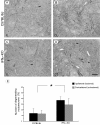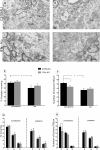Absence of IFNγ expression induces neuronal degeneration in the spinal cord of adult mice
- PMID: 21073708
- PMCID: PMC2993684
- DOI: 10.1186/1742-2094-7-77
Absence of IFNγ expression induces neuronal degeneration in the spinal cord of adult mice
Abstract
Background: Interferon gamma (IFNγ) is a pro-inflammatory cytokine, which may be up-regulated after trauma to the peripheral or central nervous system. Such changes include reactive gliosis and synaptic plasticity that are considered important responses to the proper regenerative response after injury. Also, IFNγ is involved in the upregulation of the major histocompatibility complex class I (MHC class I), which has recently been shown to play an important role in the synaptic plasticity process following axotomy. There is also evidence that IFNγ may interfere in the differentiation and survival of neuronal cells. However, little is known about the effects of IFNγ absence on spinal cord neurons after injury.
Methods: We performed a unilateral sciatic nerve transection injury in C57BL/6J (wild type) and IFNγ-KO (mutant) mice and studied motoneuron morphology using light and electron microscopy. One week after the lesion, mice from both strains were sacrificed and had their lumbar spinal cords processed for histochemistry (n = 5 each group) and transmission electron microscopy (TEM, n = 5 each group). Spinal cord sections from non-lesioned animals were also used to investigate neuronal survival and the presence of apoptosis with TUNEL and immunohistochemistry.
Results: We find that presumed motoneurons in the lower lumbar ventral horn exhibited a smaller soma size in the IFNγ-KO series, regardless of nerve lesion. In plastic embedded sections stained with toluidine blue, the IFNγ-KO mice demonstrated a greater proportion of degenerating neurons in the ventral horn when compared to the control series (p < 0.05). Apoptotic death is suggested based on TUNEL and caspase 3 immunostaining. A sciatic nerve axotomy did not further aggravate the neuronal loss. The cellular changes were supported by electron microscopy, which demonstrated ventral horn neurons exhibiting intracellular vacuoles as well as degenerating nuclei and cytoplasm in the IFNγ-KO mice. Adjacent glial cells showed features suggestive of phagocytosis. Additional ultrastructural studies showed a decreased number of pre-synaptic terminals apposing to motoneurons in mutant mice. Nevertheless, no statistical difference regarding the input covering could be detected among the studied strains.
Conclusion: Altogether, these results suggest that IFNγ may be neuroprotective and its absence results in neuronal death, which is not further increased by peripheral axotomy.
Figures










Similar articles
-
Spinal motoneuron synaptic plasticity after axotomy in the absence of inducible nitric oxide synthase.J Neuroinflammation. 2010 May 24;7:31. doi: 10.1186/1742-2094-7-31. J Neuroinflammation. 2010. PMID: 20497552 Free PMC article.
-
Decreased MHC I expression in IFN γ mutant mice alters synaptic elimination in the spinal cord after peripheral injury.J Neuroinflammation. 2012 May 7;9:88. doi: 10.1186/1742-2094-9-88. J Neuroinflammation. 2012. PMID: 22564895 Free PMC article.
-
Opposing effects of Toll-like receptors 2 and 4 on synaptic stability in the spinal cord after peripheral nerve injury.J Neuroinflammation. 2012 Oct 23;9:240. doi: 10.1186/1742-2094-9-240. J Neuroinflammation. 2012. PMID: 23092428 Free PMC article.
-
Apoptosis of spinal interneurons induced by sciatic nerve axotomy in the neonatal rat is counteracted by nerve growth factor and ciliary neurotrophic factor.J Comp Neurol. 2002 Jun 10;447(4):381-93. doi: 10.1002/cne.10248. J Comp Neurol. 2002. PMID: 11992523
-
MHC class I upregulation is not sufficient to rescue neonatal alpha motoneurons after peripheral axotomy.Brain Res. 2008 Oct 31;1238:23-30. doi: 10.1016/j.brainres.2008.08.032. Epub 2008 Aug 23. Brain Res. 2008. PMID: 18775685
Cited by
-
Plasma Erythropoietin, IL-17A, and IFNγ as Potential Biomarkers of Motor Function Recovery in a Canine Model of Spinal Cord Injury.J Mol Neurosci. 2020 Nov;70(11):1821-1828. doi: 10.1007/s12031-020-01575-y. Epub 2020 May 16. J Mol Neurosci. 2020. PMID: 32418163 Free PMC article.
-
Cytokine dysregulation in autism spectrum disorders (ASD): possible role of the environment.Neurotoxicol Teratol. 2013 Mar-Apr;36:67-81. doi: 10.1016/j.ntt.2012.07.006. Epub 2012 Aug 17. Neurotoxicol Teratol. 2013. PMID: 22918031 Free PMC article. Review.
-
Prefrontal dopaminergic and enkephalinergic synaptic accommodation in HIV-associated neurocognitive disorders and encephalitis.J Neuroimmune Pharmacol. 2012 Sep;7(3):686-700. doi: 10.1007/s11481-012-9345-4. Epub 2012 Mar 6. J Neuroimmune Pharmacol. 2012. PMID: 22391864 Free PMC article.
-
Proinflammatory and Immunomodulatory Gene and Protein Expression Patterns in Spinal Cord and Spleen Following Acute and Chronic High Thoracic Injury.J Inflamm Res. 2023 Aug 8;16:3341-3349. doi: 10.2147/JIR.S417435. eCollection 2023. J Inflamm Res. 2023. PMID: 37576153 Free PMC article.
-
Synaptic Plasticity on Motoneurons After Axotomy: A Necessary Change in Paradigm.Front Mol Neurosci. 2020 Apr 30;13:68. doi: 10.3389/fnmol.2020.00068. eCollection 2020. Front Mol Neurosci. 2020. PMID: 32425754 Free PMC article. Review.
References
Publication types
MeSH terms
Substances
LinkOut - more resources
Full Text Sources
Research Materials

